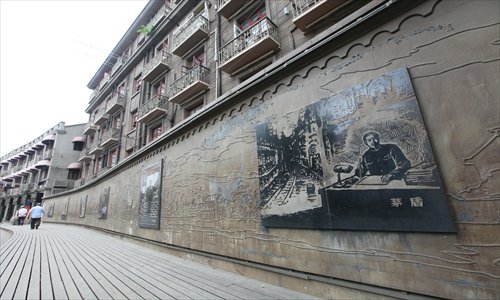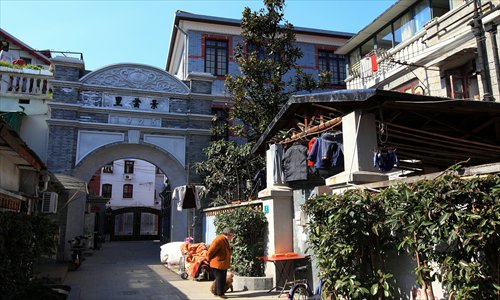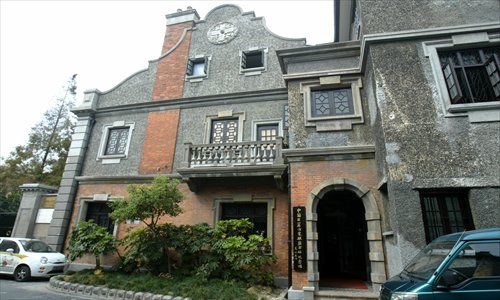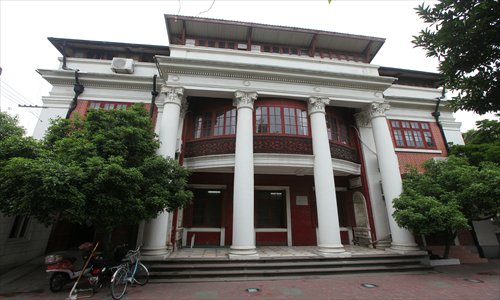Walking with the writers

Duolun Road is best known as Shanghai's street of left-wing writers - many of the country's great and influential writers wrote and lived here in the 1920s and 1930s. But the 550-meter road, now a pedestrian zone, has had a checkered history in the city. Located in Hongkou district with the bustling commercial area of Sichuan Road North to the south and Hongkou Football Stadium at the north, Duolun Road has been running its L-shape course for just over a century.
Up until 1904 the winding thoroughfare was farmland - paddocks and scattered trees. In 1904 Sichuan Road North was established, bringing homes and business and development to the area. In 1911 John Darroch, a British missionary, began constructing the road in the then American concession. He broadened the narrow street on the south and reclaimed the small creek on the west, and named it Darroch Road after himself.
After the official handover of all the concessions in the summer of 1943, the road became one of the 245 concession streets or roads built by foreigners which were renamed by the government of Wang Jingwei, the president of the Japanese-backed puppet regime. Along with most Shanghai streets being renamed after other places in China, this road was called Duolun after the distant county in today's Inner Mongolia Autonomous Region.

A safe retreat
Because Duolun Road was on the boundaries of the International Settlement and under the de facto Japanese military occupation between 1932 and 1945, it was considered a comparatively safe place for left-wing writers to live and work and avoid the Kuomintang government's persecution.
Guo Moruo, one of the country's literary trailblazers, moved to 110 Darroch Road (now No.89, Lane 201 Duolun Road) in November 1927. This is where he gave the final touches to a translation of Faust which was published in February 1928. Guo did not remain for long on Duolun Road - he left for Japan the same month.
Right on the back of Lane 125 Duolun Road is Lane 35 Hengbang Road, or "Jingyunli," where three rows of three-story shikumen (traditional Shanghai-style houses with stone gates) were built in 1924. Ye Shengtao, who started his literary career inspired by the New Culture Movement in 1919 and became a prominent writer and publisher, was among the earliest tenants.
During his stay at 11 Jingyunli between May 1927 and the spring of 1932, Ye completed and serialized his novel Ni Huanzhi (1928) in the Chinese Educational Review. First published in August 1929 and reprinted in 13 editions from 1930 to 1949, the tale of an intellectual who was disillusioned after the New Culture Movement yet found renewed hope in revolution upon death, is one of Ye's most widely-acclaimed works. He was also the editor in chief of the literary magazine Fiction Monthly, through which he introduced the works of progressive young writers including Ding Ling and Ba Jin, both of whom made their socialist convictions clear in their writings and achieved widespread popularity.
In August 1927, 11 Jingyunli saw the arrival of the then obscure Mao Dun, who flourished later to become one of the greatest modern Chinese novelists, and, after 1949, the country's minister of culture. Mao Dun spent four weeks in an apartment in the shikumen writing his debut novella Disillusion, which was serialized in the Fiction Monthly later that year.
It was also at Jingyunli that Mao wrote Vacillation (1927) and Pursuit (1928). The three novellas, focusing on young revolutionaries' devotion, despair, and doubt in the ups and downs of revolution during the years between 1923 and 1927, form his Eclipse trilogy.

A leading figure
Lu Xun, the leading figure of modern Chinese literature and the country's most acclaimed 20th century writer and critic, also lived there. In October 1927, he visited his younger brother Zhou Jianren at 1o Jingyunli and decided to make the area his home in Shanghai. He lived on the third floor of 23 Jingyunli for a year before moving into 18 Jingyunli in September 1928 and 17 Jingyunli in February 1929.
Lu Xun was close to some of the outspoken Communist writers like Rou Shi, the young author of the novelette February who lived at 23 Jingyunli in 1928 until he was executed by the Kuomintang in 1931. Lu also befriended the Japanese left-wing writer Kenza Uchiyama and the American pro-Communist journalist Agnes Smedley.
There was more than writing going on in Duolun Road. In September 1928, the linguist Chen Wangdao and the translator Wang Fuquan opened the Dajiang Bookstore at 4 Jingyunli. The bookstore featured literary and arts magazines, and the works of Lu Xun, Mao Dun, and Ding Ling among many others. It promoted Marxist publications.
At the intersection of Duolun Road and Sichuan Road North, where the Shanghai Fashion Shopping Center now stands, was the Gongfei Café, a three-story brick structure. In the 1920s and 1930s, the café was run by the city's Japanese residents. Visitors shopped for candies and pastries on the first floor and drank coffee on the second and third floors.
In his story Revolutionary Café, Lu Xun describes the café in this way: "Having conversations or contemplating in front of a mug of hot, proletarian coffee makes this place a place of ideals."
The café was used as a meeting place for left-wing writers and activists, who gathered here on February 16, 1930 to discuss the founding of a modern art and literature group. On March 2, 1930, the League of Left-Wing Writers was officially established down a side alley at 233 Darroch Road (now No.2, Lane 201 Duolun Road). This British neoclassical building was built in 1924 and was at that time the campus of the Arts University of China.
In one large classroom, Lu Xun, the league's prime organizer and titular head throughout its six years, gave the opening speech "My View on the League of Left-Wing Writers" in front of its 50 or so members including the playwright Tian Han (who later composed the lyrics for the national anthem of the People's Republic of China) and the writer and poet Yu Dafu.
Lu Xun appealed for a shift in literature and arts for the purpose of exciting and inspiring the "general public of workers and farmers" and suggested left-wing writers should examine real-life social conflicts.
The group had an important impact on modern Chinese literature as well as translations - within five years, its members had translated works of Marxist literary theory alongside progressive literary publications, mostly from the Soviet Union. It is widely considered that the league's introduction of Marxist literary theory laid the groundwork for the proletarian literary theories that emerged during the War of Resistance against Japanese Aggression (1937-45).

A variety of styles
Boasting some 20 elegant mansions in a variety of international architectural styles, Duolun Road is also a showpiece for Shanghai architecture. The outstanding house on the road is the 638-square-meter mansion at 210 Duolun Road. Currently housing the stomatology department for a navy hospital, it was built in the 1920s by two brothers, businessmen from Guangdong Province. With an impressive entrance of four two-story columns and a white marble facade, it is a good example of French neoclassical design. The balcony on the second floor features exquisitely metal filigree work and the first floor delights include hand-painted tiles.
During the War of Resistance against Japanese Aggression, the building was occupied by Japanese officers before the National Revolutionary Army took it over. When the noted general Bai Chongxi was suddenly dismissed from the post as minister of national defense of the Republic of China (1912-1949) in June 1948, he decided to settle down in Shanghai. The building became his private residence and from then on was referred to as "Bai's Mansion" before it was taken over by the People's Liberation Army Navy in 1949. Pai Hsien-yung (Bai Xianyong), the son of Bai and a leading Taiwan writer, spent part of his childhood here.
The Spanish Garden home at 215 Duolun Road was built in 1925. The owner Li Guansen was yet another Guangdong businessman who made a fortune in Shanghai. The wood-and-brick building features an octagonal hall on the second floor connecting the dining room, kitchen, and bathrooms, and two balconies offering superior views of the garden. Today it is used as a nursing home for textile workers.
The two-story home at 250 Duolun Road was created in 1924. Its Islamic-style design stands in marked contrast with the other homes in this area. The geometrical tiling and mosaics are unique and impressive even in this city. This building became one of the three private residences belonging to the influential banker and politician Kong Xiangxi after 1945. Long gone is its exclusiveness - ordinary Shanghai families have been living here ever since then.